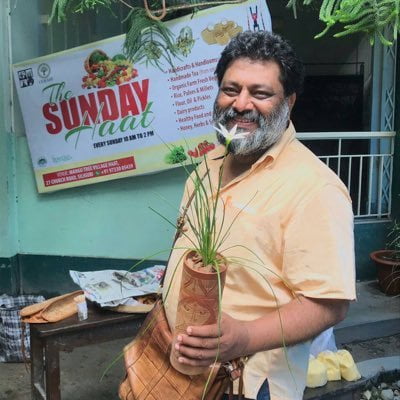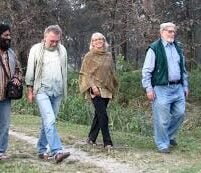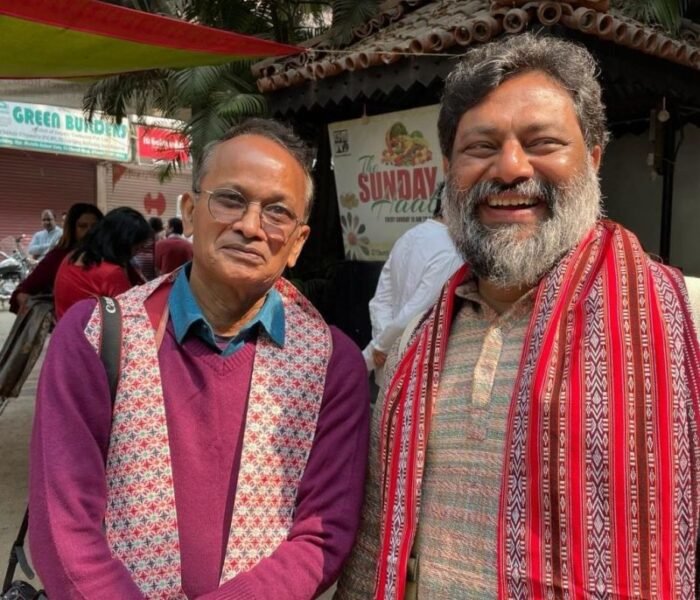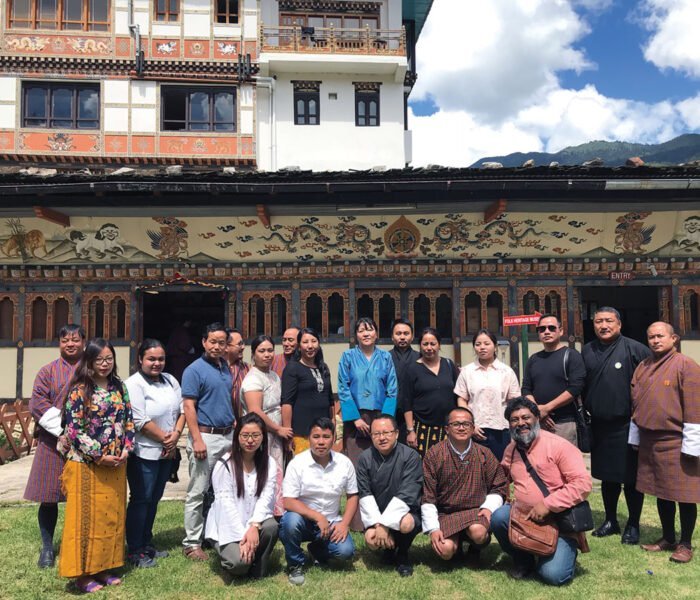No products in the cart.
Raj Basu – India’s Tourism Gandhi
Advocating Ecotourism: Raj Basu's Tireless Efforts in Empowering India's North East through Responsible Tourism
Interview by Ranee Sahaney
His relentless pursuit in promoting India’s North East Region has been backed by an abiding passion for empowering the local communities through rural tourism. Raj Basu’s name resonates across many fora for Ecotourism and Responsible Tourism, both national and international, for his selfless drive to add value to the enormous tourism potential of the region.
Strangely modest about his huge contributions to India’s tourism sector, Raj, oftentimes called the ‘Tourism Gandhi’, is frequently found travelling across the rural expanses of the East and Northeast India, Nepal and Bhutan, encouraging local communities to protect their customs and traditions and help transform these into powerful components for tourism in these regions.
You are a railway man’s son; can you tell us about your personal journey that has brought you to where you are today in India’s tourism arena?
It’s been an amazing cultural adventure with many challenges and highs— along with vast amounts of learnings about the human condition in a rapidly changing natural environment. For me this is a never-ending saga which continues to enrich my own life as I work with communities and witness the transformation of their lives with even the smallest contributions I bring to them.
My father being a railway man meant that he’d get transferred a lot. That meant I got to live with my maternal grandparents, aunts, and uncles in their lovely house nestling by the Karala River in Jalpaiguri in the Dooars. My mother’s father, Santosh Paul, was part of the Indian Independence movement.
I must admit I was a bit of a brat, being thoroughly spoiled as the only grandson. I was five when we had to shift to Siliguri, because the flooding of the Teesta resulted in destroying their home. My mother and I joined my father in Siliguri in his parents’ home. My grandfather had also just retired from the Chengmari Tea Estate, located on the Bhutan border.
Even as a young child I got to love the great outdoors and had a great affinity to Nature. Home lay in proximity to Sevoke forest (known now as the Mahananda Wildlife Sanctuary) and the legendary Baikunthapur forest. As a local child I uncovered many secrets of these beautiful forested enclaves. One was about the small ashrams that lay hidden in their depths. The village communities living deep in these jungles (of which the British had no clue) would send their kids and youths to these critical centres of learning free from any stigma of class barriers.
Then, there was all that talk amongst the elders about the freedom struggle— and more important for me at the time, those conversations which reflected that deep connection to the wilderness. All this definitely left its imprint on my worldview. These childhood memories would instil in me an abiding fascination for nature and the lore of the Northeast.
My boundless energy and naughtiness were too much for my grandmother to handle, so in Class VI, I was packed off to study in the Garhwal Himalaya in Mussoorie’s Oak Grove School; the school was also known as the “Railway School” amongst the locals living in Jharipani where it was located.
This turned out to be a watershed experience as I had jumped out of my own little pond back home to discover a world where students were drawn from all corners of the country. Once again there was a shifting of the kaleidoscope of my worldview— and I greedily soaked up the idea of being a part of the greater India. It was here too that, as a boy scout, I got a formal introduction to hikes and treks, camping and independent living.
These became treasured learnings which were put to good use when I bunked college in Siliguri to take off to the hike and explore the Bengal Himalayan region.
My life it seemed was definitely connected to the outdoors, rather than the confining vistas of an office as a pen-pushing- babu! That first Sandakphu trek, in the Singalila Range near Darjeeling, wedded me to the region for life as I exhilarated in the flow of thrilling activities of tree planting programmes, trekking, mountaineering, camping and more.
Later, as a research assistant for tiger projects in eastern India – in the Sundarbans, Buxa and Namdapha, I gathered many lifelong lessons in interacting with NGOs, conservationists and wildlifers.
I found myself back again in the Garhwal Himalayas as an adventure activity professional. I relished with great delight those opportunities to organize adventure activities like white rafting, mountain biking and treks. I discovered that I had a great appetite to embrace this world even more completely. What was doubly exciting was that opportunities also arose for me to pursue my interests and delight in wildlife, conservation and tourism.
I loved it all— but the pull of home was strong. It wasn’t too long before I found myself back in the Northeast, when an opportunity cropped up to work with the Sikkim government in a similar capacity. These immersive experiences were quite novel at the time to the region then.
Tell us how setting up Help Tourism became a stepping stone to a more immersive connection to the Northeast?
Help Tourism was set up in collaboration with two of my college friends in 1991. At the time we were the only organisation promoting adventure-centric tourism in Eastern and Northeastern India. In 1990, I had realized that Sikkim cannot be developed in isolation in tourism and should also include the Darjeeling Hills and the Dooars. We swallowed the ridicule we faced at the idea, and went ahead with our plans!
How did the ‘local community’ factor emerge in your growth trajectory?
Even in those early days, despite the fact we offered adventure activities in remote, pristine areas, there was barely any involvement of the local communities. This thinking resulted in our concept of homestays, probably the first in the country, so tourists could live in local homes. The idea eventually caught up with both the locals and the visitors.
After we established the first four homestays of India in Tinchuley in collaboration with WWF India the rest became history. Next to come up were the homestays at Lava, gateway to the Neora Valley National Park, and Lataguri, the entry point for Gorumara National Park. We have never looked back since as we continue to open up homestays in more and more places around the Northeast and allied regions.
So, this became the trigger for the movement for encouraging local communities to protect their natural heritage through direct involvement and ownership in tourism. As I said before, there’s been no looking back for us since.
Your name has long been associated with Community Tourism and conservation and Village Livelihood Programs in India’s Northeast region. What was the inspiration to shift your attention from the day-to-day running of Help Tourism to this space?
While Help Tourism’s core operations continued apace, I found myself more and more involved with the village communities and helping better their lives through tourism as a whole.
In our thinking conservation or rural tourism was a means to empower locals to protect their natural heritage. Increasingly, we found like-minded people from all kinds of professions wanting to join our conservation tourism movement.
‘Association for Conservation and Tourism’ (ACT), the NGO we formed in this endeavour was registered in 2001; at the time it was the first conservation tourism NGO of the country.
What drives our mission is a realistic outlook— that conservation tourism without local people is impossible. The ownership has to be with the local people. The footprint of our ‘ACT’ivities spread to over 50-60 villages. Back in the late 90s people were calling it the ‘Help Tourism Movement’ under the banner of the ‘Association for Conservation and Tourism’.
Any success story that stands out from those days?
One of our big success stories was our connection with the small village of Lakkhi Bazaar in Manas which was in a state of isolation because of the Bodo movement insurgency. Poaching in Manas National Park, a World Heritage Site, had become a big menace. Having decided to get involved we began the ‘Manas Maozigendri Ecotourism Society’, another first for the country.
At the outset we focused on 500 sq km of the park’s core area of Manas National Park and involved villagers in its conservation. As a result, those men who were poachers became an extended hand of the Forest Department, their rifles now being used for conservation rather than insurgency. Also, once we were able to establish that the elephant populace was thriving again in the National Park, we were able to win back Manas’ designation as a World Heritage Site. What resonated even more deeply with me was that for conservation to succeed, it has to come from inside.
Our ‘Manas Maozigendri’ initiative grabbed the limelight, resulting in the change in the conversation about how conservation can be achieved, not just through officialdom but from the local communities.
Our policymakers fail to understand that their livelihoods and economy have to be connected to the ecology of the region. Their inter-generational efforts to conserve this land, which is one of our best insurances against climate change, must first be of benefit to them.
You are now deeply involved in an advisory role with state governments in the East Himalayan and Indo-Burman region on tourism. How important has this been in terms of the future trajectory of tourism in these states?
As Advisor, Rural Tourism for Arunachal Pradesh, amongst my key efforts is to encourage and enable cross-border collaboration on conservation and sustainable tourism.
We also began working in eastern Nepal, northern Bangladesh, Bhutan, Upper Myanmar etc; these cross-border efforts helped put the spotlight on how biodiversity shared across landscapes can benefit communities.
Conservation tourism, we continue to learn, doesn’t have to be in isolation. Fired by this thought we have helped adjoining neighbouring countries to create rural tourism homestay policies, organised training programmes, and included them in festivals and other promotional activities, in the arrangement of which we have been involved for many years.


























Mr. Raj Basu sir is truly an asset for the Indian tourism sector. Spreading knowledge about India’s magnificent culture to the world.
Very good article and regards to Raj Basu Sir for his excellent work for eco-tourism
Indian Govt should take help of Mr Raj Basu for the devlopment of responsible tourism, as our PM Shri Narendra Modi said many times to develop domestic tourism. This can create lot of jobs in travel and tourism sector.
I lived in the Dooars and Assam for many years and so it gives me much happiness to see the efforts of Mr Raj Basu in restoring these regions to their natural beauty in such a wonderfully sustainable way.
Yes I absolutely agree with the narratives which was known to Me since long back .Today seeing the development of Tourism industry vacked by ecological preservation and its sustainability I strongly opine the mission carried our by Sri Raj Basu ji be given due weightage by our highest office of Bharat ie., our most respected P.M Sri Narendra Modi ji by honouring and simultaneously presenting him a ideal personality for development of Tourism industry through multiplier effect .
I strongly admire his immense personality and knowledge bank with sincerity and honesty of purpose to make Tourism a great industry in Bharat Getting Highest national award therefore certainly is the clarion call for Our most loved and respected Supratim Raj Basu ji .
देवज्योति लाहिड़ी ।
कोलकाता ।
भारत ।
Inconvenience for erroneous typing regretted .Wrongly typed vacked .
Correct word is Backed .kindly read the narratives accordingly.
Debojyoti Lahiri.
देवज्योति लाहिड़ी ।
कोलकाता ।भारत ।
Raj Basu is always an inspiration.
Mr. Basu deliver information exact and authentic that really value to tourist. His passion reflect in his writings.His experience saves many of visitors’ time and money sometimes as veteran guide like.